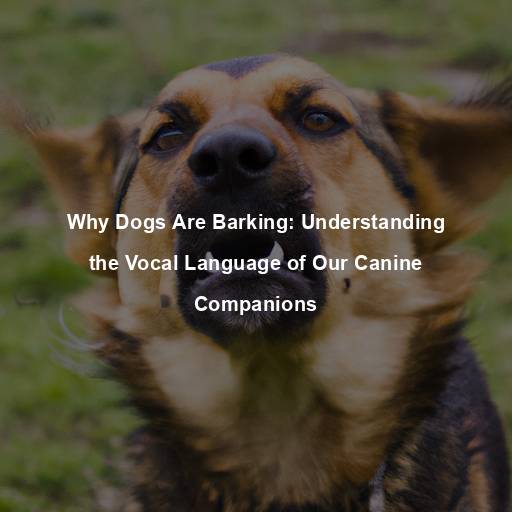Why Do Dogs Pant: Unveiling the Mystery Behind Canine Panting
Last Updated on July 23, 2023 by Evan
Contents
- 1 Understanding the Mechanics of Canine Panting
- 2 Decoding the Emotional Aspects of Panting
- 3 When to Be Concerned: Abnormal Panting
- 4 Supporting Your Dog’s Well-Being
- 5 Tips for Managing Panting and Promoting Canine Comfort
- 5.1 Provide Ample Water and Hydration
- 5.2 Create a Cool and Shaded Environment
- 5.3 Avoid Excessive Physical Exertion in Hot Weather
- 5.4 Utilize Cooling Aids and Techniques
- 5.5 Consider Professional Grooming and Coat Maintenance
- 5.6 Monitor and Address Underlying Health Issues
- 5.7 Provide Mental Stimulation and Emotional Support
- 6 The Fascinating World of Canine Panting
- 7 FAQs – Why do Dogs Pant?
Understanding the Mechanics of Canine Panting
Dogs panting is a common behavior that we have all witnessed countless times. But have you ever wondered why our furry friends engage in this seemingly strange activity? Panting in dogs serves a vital purpose, acting as their natural cooling system. Unlike humans who sweat to cool down, dogs lack sweat glands, making panting their primary means of thermoregulation.
The Physiology of Panting
Panting involves rapid and shallow breaths, allowing dogs to exchange warm air from their lungs with cooler air from the environment. As dogs breathe in, the air passes through their nasal passages and over their moist tongue, which aids in evaporative cooling. The evaporation of moisture from the tongue, combined with the heat exchange occurring in the respiratory system, helps dogs regulate their body temperature effectively.
Panting as a Sign of Physical Exertion
Ever wondered why your furry friend goes into overdrive with panting after an intense game of fetch or a vigorous run in the park? Well, panting isn’t just a cute canine quirk, it actually serves a purpose beyond just cooling off. When dogs exert themselves through physical activities, their bodies produce more heat, leading to an increase in panting. It’s their way of shedding that excess heat and bringing their body temperature back to normal.
Decoding the Emotional Aspects of Panting
Panting, the mechanism commonly associated with regulating body temperature, possesses a fascinating dimension that extends beyond its physiological purpose. Surprisingly, this elemental act can also be evoked by a mesmerizing array of emotions. Similar to us humans, our loyal canine companions embrace a rich tapestry of feelings, and panting emerges as their unique mode of communication amidst this complex emotional landscape. Let us delve into the intricate world of panting and unravel the mystifying connection between this innate response and the profound emotional spectrum of our beloved dogs.
Anxiety and Stress
Panting can be a telltale sign of anxiety or stress in dogs. When faced with a stressful situation, such as thunderstorms, fireworks, or visits to the veterinarian, dogs may exhibit panting as a coping mechanism. The act of panting helps dogs release tension and can be seen as a self-soothing behavior. If your dog displays panting in stressful situations, it is essential to create a calm and safe environment to alleviate their anxiety.
Pain and Discomfort
Have you ever wondered why our furry friends occasionally pant? It turns out that panting can actually be a sign of pain or discomfort for dogs. Since our four-legged companions can’t have a heart-to-heart with us, panting is their way of communicating that something just isn’t right. So, if you notice your pooch panting more than usual and can’t pinpoint the cause, it’s important to play detective and keep an eye out for other signs of distress.
Excitement and Anticipation
Panting can also be a reflection of excitement and anticipation in dogs. When dogs are eager or excited about something, such as a walk, playtime, or the arrival of their favorite human, they may display panting as a means of expressing their enthusiasm. It is important to differentiate this type of panting from stress-related panting, as excitement-induced panting is generally short-lived and accompanied by a wagging tail and an overall joyful demeanor.
When to Be Concerned: Abnormal Panting
While panting is a normal behavior for dogs, there are instances where it can indicate an underlying problem. Abnormal panting refers to excessive, prolonged, or irregular panting that goes beyond what is considered typical for a particular situation. Being aware of these signs can help you identify when your dog’s panting may require further attention.
Heatstroke and Overheating
With scorching summer days upon us, it’s essential to keep a watchful eye on our furry companions. Panting may seem like a normal behavior for dogs, but when it becomes excessive, it could indicate a greater concern – heatstroke. Pets are particularly vulnerable to the perils of overheating, making it crucial to be proactive in spotting the early signs. If your pup’s panting is coupled with symptoms like drooling, weakness, a racing heartbeat, or even vomiting, it’s imperative to act swiftly.
Respiratory Issues
When it comes to our canine companions, abnormal panting can leave us in a state of concern and confusion. The reasons behind this mysterious behavior can be as varied as the colors on a painter’s palette. From respiratory issues lurking beneath the surface to the sneaky culprits like laryngeal paralysis, tracheal collapse, or heart disease, our furry friends can pant excessively for reasons we may not easily comprehend. It is imperative, dear reader, that if your loyal companion’s panting becomes entangled with coughing, wheezing, or labored breathing, you seek the wise counsel of a veterinarian to unravel this intricate puzzle of respiratory health.
Pain, Injury, or Illness
When it comes to our furry friends, deciphering their mysterious ways can often leave us feeling perplexed. Take panting, for example – while it’s perfectly normal for dogs to pant, excessive and prolonged panting can be a sign that something is amiss. Whether it’s caused by pain, injury, or illness, our canine companions aren’t able to voice their discomfort in the same way we do. So, if you notice your beloved pup panting persistently, it’s important to keep a keen eye for other telltale signs like limping, loss of appetite, or changes in behavior.
Supporting Your Dog’s Well-Being
Ensuring our furry companions’ contentment is a heartfelt obligation we hold dear as conscientious pet owners. Delving into the enigmatic world of doggie panting, we unveil a myriad of perplexing reasons that underlie this peculiar behavior. To ensure we tackle any lurking worries and bolster our dogs’ bliss, here are a handful of insightful tips to invoke their wellbeing and serenity.
Regular Exercise and Mental Stimulation
Providing your dog with regular exercise and mental stimulation is crucial for their physical and emotional well-being. Engaging in activities tailored to their breed, age, and energy level helps prevent excessive panting due to pent-up energy or boredom. Regular exercise also promotes a healthy weight and minimizes the risk of obesity-related breathing difficulties.
Ensuring a Comfortable Environment
As pet parents, we constantly strive to provide our furry friends with the absolute best. When summer rolls around, it’s crucial to keep our dogs cool and content. This means ample shade, cool water, and a well-ventilated area where they can relax and unwind. Remember, the last thing we want is for our beloved companions to suffer from heat-induced panting or, even worse, the dreaded heatstroke.
Regular Veterinary Check-ups
Routine veterinary check-ups are crucial for monitoring your dog’s overall health and identifying any potential underlying issues. Regular examinations, vaccinations, and preventive care can help catch and address health concerns before they escalate. Your veterinarian can provide personalized advice and recommendations based on your dog’s specific needs.
Addressing Anxiety and Stress
If your dog experiences anxiety or stress-related panting, it is important to address the underlying causes and provide them with appropriate support. Consult with a professional dog trainer or behaviorist to develop a tailored plan to help your dog manage their anxiety. Creating a safe space, providing comforting toys, and implementing positive reinforcement techniques can also aid in reducing stress-induced panting.
It’s remarkable how our canine companions never fail to captivate us with their unique behaviors and habits. One such behavior that often leaves us pondering is the act of panting. The enigmatic nature of panting becomes even more perplexing when we consider how it varies among different dog breeds. From the exuberant panting of a playful Labrador Retriever to the delicate and subtle panting of a regal Afghan Hound, each breed exhibits its own distinct panting style.
When it comes to panting, dogs are a fascinating bunch. While every dog pants, there are certain breeds that bring a whole new level of intrigue to this classic canine behavior. From genetic quirks to physical attributes, these breeds showcase a range of unique panting characteristics that leave us both captivated and perplexed. So, let’s take a closer look at these marvels of panting and uncover the secrets behind their fantastic antics.
Brachycephalic Breeds
Brachycephalic breeds, such as Bulldogs, Pugs, and Boxers, have a distinct facial structure characterized by a shortened muzzle and compressed airways. These breeds often pant more frequently and heavily compared to other breeds. Their anatomy makes it more challenging for them to breathe efficiently, especially in hot and humid conditions. If you own a brachycephalic breed, it’s crucial to be extra vigilant in monitoring their panting and ensure they have access to a cool and well-ventilated environment.
Double-Coated Breeds
Did you know that some of our favorite furry companions have a secret weapon for tackling unpredictable climates? Take double-coated breeds like the majestic Huskies, Malamutes, and Samoyeds, for instance. These gorgeous creatures boast a unique blend of a dense undercoat and a longer outer coat, which helps them stay comfortable no matter the weather. Though they may not pant as often as other breeds, their panting can still offer valuable insights into their well-being, especially during scorching summers or vigorous exercise sessions.
Toy and Small Breeds
Toy and small breeds, such as Chihuahuas, Yorkshire Terriers, and Pomeranians, have a higher metabolic rate compared to larger breeds. As a result, they may pant more often to dissipate heat and regulate their body temperature. However, it’s important to differentiate between normal panting and excessive panting in these breeds, as they may be more prone to respiratory issues due to their smaller airways. Regular veterinary check-ups and appropriate exercise and environmental management are crucial for their well-being.
Tips for Managing Panting and Promoting Canine Comfort
As devoted companions to our furry friends, it’s natural for us to worry about their well-being, especially when it comes to their panting habits. Fear not, for there are various proactive measures we can put into motion to address this concern and guarantee the utmost comfort and safety for our beloved pets. To set your mind at ease, here are a handful of invaluable tips you can consider implementing to tackle this quizzical phenomenon.
Provide Ample Water and Hydration
As a dog owner, one of the key responsibilities we have is ensuring our furry friends stay hydrated – a particularly crucial task when the sun’s rays are beaming or your pup is experiencing a vigorous playtime session. Adequate hydration not only aids in regulating their body temperature but also supports the optimal functioning of their internal organs. To make this task a breeze, one could explore spill-proof water bowls or even invest in a portable water dispenser for those thrilling outdoor adventures. With these ingenious solutions, you can rest assured that your dog will be blissfully quenched and bursting with vitality.
Create a Cool and Shaded Environment
As the sun blazes and temperatures soar, our furry companions count on us to help them beat the heat. Creating a haven of coolness for your dog is essential, especially during those scorching summer days. Give them access to breezy retreats, equipped with fans or air conditioning, or designate a space with a refreshing cooling mat. Remember to avoid subjecting your pooch to direct sunlight or trapping them in stuffy surroundings, ensuring they have the airflow they need to stay comfy.
Avoid Excessive Physical Exertion in Hot Weather
When the scorching sun decides to make its presence felt, it becomes crucial to tweak your furry companion’s exercise regimen to evade the perils of overheating. Steer clear of high-octane activities during the sweltering peak hours and instead embrace the cooler ambiance of the early morn or twilight for leisurely strolls. Mindful observation of your dog’s non-verbal cues and the intensity of their panting during physical exertion will enable you to fine-tune the duration and vigor of their workout seamlessly.
Utilize Cooling Aids and Techniques
With the sweltering heat of summer upon us, it’s important to keep our furry friends cool and comfortable. But fear not, as there are a plethora of innovative ways to help regulate your dog’s body temperature. From the simple act of wetting their paws, belly, or ears with refreshing cool water to investing in specialized cooling vests, bandanas, or mats, the options are endless. However, it’s crucial to seek guidance from your veterinarian to ensure the safety and efficacy of these cooling aids.
Consider Professional Grooming and Coat Maintenance
Taking care of your furry friend’s grooming needs is vital for their overall well-being and temperature control. To ensure your dog stays comfortable, especially in the summer, professional grooming services can help by getting rid of excess fur and preventing tangled hair. But keep in mind that not all breeds require the same grooming routine, as excessive trimming or shaving might expose them to skin problems or sunburn. Consulting with a professional groomer will help you determine the best course of action for your dog’s breed.
Monitor and Address Underlying Health Issues
Is your furry companion huffing and puffing more than usual? Well, that could be a red flag for some serious health issues lurking beneath the surface. Don’t play guessing games with your pet’s well-being—book those regular check-ups pronto! Keep the conversation flowing with your vet about your pup’s panting habits, because they might just hold the key to unlocking hidden health mysteries.
Provide Mental Stimulation and Emotional Support
In addition to physical well-being, mental stimulation and emotional support are vital for your dog’s overall happiness. Engage in interactive play sessions, provide puzzle toys, and establish a routine that includes mental exercises to keep their minds sharp and engaged. Furthermore, ensure a nurturing and positive environment, as stress and anxiety can contribute to excessive panting in some dogs.
When it comes to our furry friends, we know that each and every dog has their own special quirks and needs. It’s important for us, as pet owners, to really tune in to our dog’s behaviors and understand what makes them tick. Whether it’s deciphering their panting language, setting up a cozy corner for them, or reaching out to experts for advice, we hold the key to keeping our loyal companions content and in tip-top shape. So let’s embrace the joyful puzzle of dog ownership, and commit ourselves to the endless pursuit of tail-wagging happiness for our four-legged family members.
The Fascinating World of Canine Panting
Delving into the enigma surrounding the perplexing phenomenon of canine panting has opened a gateway to a vast realm of captivating insights into both their physical and emotional realms. Beyond the mere act of thermoregulation, panting in dogs presents a multi-faceted tapestry, revealing the complex web of communication they employ. Armed with this knowledge, we can navigate the labyrinthine intricacies of panting, identifying anomalies or excessive patterns, and bestow our loyal companions with the care and affection they so rightly merit.
Have you ever paused to marvel at the intricate dance of panting that your furry companion performs? It’s truly a remarkable symphony of bodily mechanisms, designed to cool them down and keep them comfortable. Let’s not forget the extraordinary connection we share with our four-legged friends and the responsibility we have to nurture their happiness and well-being. So, the next time you notice your dog panting, awe at the beauty of nature’s design and respond with empathy and love, because every moment spent ensuring their comfort is a moment well-spent.
FAQs – Why do Dogs Pant?
Why do dogs pant?
Have you ever wondered why dogs pant so much? Well, it turns out that panting is actually a natural mechanism they use to regulate their body temperature. Unlike us humans, who have sweat glands all over our bodies, dogs rely on panting to cool down. This fascinating process involves the evaporation of moisture from their tongues and upper respiratory tract, allowing them to release heat and maintain a comfortable body temperature. So, the next time you see your furry friend panting, know that they’re just trying to beat the heat or recover from an intense play session!
When do dogs pant the most?
When it comes to our furry friends, panting can be as perplexing as it is common. Sure, we know that dogs pant to cool down on scorching summer days or after an intense play session. However, did you know that panting can also be a sign of anxiety, stress, or even pain? This burst of breathiness can leave us scratching our heads, trying to unravel the mysterious reasons behind their excessive panting. To decode this canine conundrum, it’s essential to pay close attention to their behavior and surroundings, uncovering the hidden clues that lie within.
Who knew that the act of panting in our furry friends had such a world of complexity behind it? It turns out, panting in dogs isn’t just about regulating their body temperature. They might be panting due to a whirlwind of emotions like excitement, nervousness, or even fear. And if that wasn’t perplexing enough, excessive panting could also be a red flag for underlying medical conditions, like respiratory or cardiovascular problems. So, if your pooch is panting up a storm without any obvious reason or if something feels off, it’s best to play it safe and seek a professional opinion from a trusted veterinarian.
Can panting in dogs be a sign of distress?
It’s no secret that our furry friends have their own unique ways of expressing themselves, and panting is one of those curious behaviors that can leave us puzzled at times. While panting can be a completely normal way for dogs to cool themselves down, it can also be a sign of something deeper, like distress or discomfort. Keeping a keen eye on your dog’s overall behavior is crucial in deciphering the true meaning behind their panting episodes. Look out for additional clues such as trembling, pacing, whining, or hiding, and don’t hesitate to seek professional advice from a veterinarian if needed. After all, our pups rely on us to understand their unspoken language and ensure their well-being.
How can I help my dog when they are panting excessively?
Understanding why your dog is panting excessively is the first step in addressing this worrisome behavior. If it’s merely a response to hot weather, ensuring their access to water and a cool spot is essential. However, if it stems from anxiety or stress, creating a peaceful and secure environment for them can make a significant difference. Yet, if the excessive panting continues or is accompanied by additional alarming signs, seeking guidance from a veterinarian is the best course of action to ensure your furry friend’s overall health and happiness.







